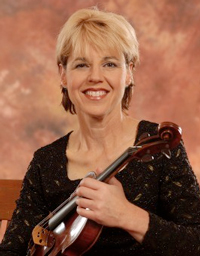by Daniel Hathaway
The Takács
Pianist Garrick Ohlssohn will be the special guest for Brahms’s Piano Quintet in f, op. 34. Also on the program are Brahms’s Quartet in a, op. 51, no. 2 and Haydn’s Quartet in B-flat, op. 76, no. 4.
Compared to other long-standing groups, the membership of the Takács Quartet has been remarkably stable over its 38-year history. British violinist Edwin Dusinberre took over the driver’s seat in 1993 and another British musician, Roger Tapping, replaced the original violist in 1994. Tapping was succeeded in 2005 by Geraldine Walther, who left her post as principal violist of the San Francisco Symphony to join the quartet. We spoke with Walther by phone in San Juan, Puerto Rico.
Daniel Hathaway: What takes you to Puerto Rico?
Geraldine Walther: We’re playing in the Casals Festival an a couple of days — a different Haydn quartet but the same Brahms quartet we’re playing in Cleveland, plus the Britten third quartet.
DH: It’s the year to play Britten!
GW: It is. We’ve been learning them for the centennial and just recorded all three for Hyperion at a studio in Wales. It’s been a great experience and a great challenge, especially the second quartet for me. It has a long chaconne and the second movement is quite difficult — it goes like a bat out of hell. I had played the first and the third before. He was extremely young when he wrote the first and it has a lot of high, soft shimmering stuff in the three upper voices which is difficult to bring off, as well as fast tempos and tricky technical passages.
DH: I believe that the quartet is spending the week between San Juan and Cleveland in New York. What will you be doing there?
GW: We’ll be working with three fabulous young string quartets at Carnegie Hall — including the Linden Quartet from Cleveland, the Spruce Quartet from Boston and the Attaca Quartet from New York. The Linden are preparing Haydn’s op. 76 no. 5 and a late Beethoven. We’ll be coaching the groups separately in private then together in public master classes. It’s a fabulous program run by the Carnegie Institute. We’ll also talk about the business of music in a session called “Powerful Programming” with Dean Sher of the University of Colorado and our manager, Seldy Cramer from the Bay area. It all ends with a public recital by the three quartets.
DH: Speaking of powerful programming, how did you put the Cleveland program together? I believe it’s the same program you’re playing the next evening at Lincoln Center.
GW: We have some very good minds for programming in the quartet; Károly, the second violinist, has an amazing artistic imagination. The Cleveland and New York program is Brahms, Haydn and Brahms. Who would have thunk it! But it actually does work and it’s a really satisfying concert to hear. Sometimes we come up with ideas because of a project — we did the Brahms two viola quintets with a colleague in Colorado who used to play with the Cavani Quartet, then repeated those at the Wigmore Hall in London. Then we went on to the piano quintets.
DH: In one of which Garrick Ohlsson will be joining you.
GW: We love playing with him and look for opportunities. When Garrick plays the piano, his tone seems to come up from the earth, it’s such a balm. He also has an encyclopedic mind. He seems to know about everything but he doesn’t come on that way. He’s a great big teddy bear of a guy with wide musical tastes — he loves to play everything and does it so fantastically well. He’s a national treasure.
DH: When you left the San Francisco Symphony after nearly thirty years, you said you were going to try things out with the quartet for a year before deciding on a permanent move.
GW: When you join a string quartet you don’t look back. I gave myself totally to the symphony and loved the repertory and the orchestra. It was hard to give up but I’m so lucky to be in such a great string quartet. You do have to take more personal responsibility. Nobody’s going to lead you to the airport — you have to get yourself to that gate!
DH: That move also meant trading the ocean for the mountains.
GW: Leaving the Bay area was tough, too, but we get to go back several times a year to perform, see friends and be a visitor to that lovely place. There’s nothing like it. But I love cowboy country and my husband is from Nevada. I love the university and the college of music. There’s a lot going on and the students are really great. The Takács has a series and the town loves and supports the quartet.
The Hungarians liked it very much when they arrived in 1986. So did Ed Dusenberry, who joined fresh out of school. He had been to Juilliard, Aspen and California, then he met his wife who is an archeologist and set up shop in Colorado, as did Roger Tapping, my predecessor — who has just joined the Juilliard.
DH: What about the altitude?
GW: If we’ve been away a while you kind of feel it the next day, but then you don’t.
DH: We’re looking forward to your return to Cleveland. The Takács have been frequent visitors to the Chamber Music Society series.
GW: That series is fantastic and Cleveland is such a rich, culture-loving town which is nurtured by the wealth of talent in The Cleveland Orchestra. We really love coming there. It’s one of the special places in the country where you feel like what really matters is art and music and one’s inner life.
Published on ClevelandClassical.com March 14, 2013
Click here for a printable version of this article.



